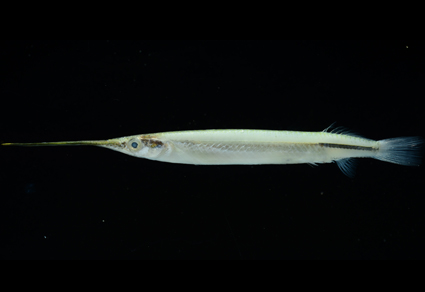Abstract
Species of the genus Zenarchopterus are marine, brackish, and freshwater fishes that have modified dorsal-fin and anal-fin rays in adult males. There are 19 valid species worldwide. Three species have been recorded from Taiwan, namely Zenarchopterus buffonis (Valenciennes, in Cuvier & Valenciennes, 1847), Z. dispar (Valenciennes, in Cuvier & Valenciennes, 1847), and Z. dunckeri Mohr, 1926. However, Collette and Su (1986) noted one uncertain species (female, labeled “Zenarchopterus sp., Takao, Formosa, Hans Sauter, V–VII 1907”) in the Museum of Nature Hamburg (ZMH) from southern Taiwan. This species has only nine pectoral-fin and anal-fin rays, a longer snout, and does not agree well with any other species. In this study, Zenarchopterus takaoensis sp. nov. is described based on seven newly collected specimens from southwestern Taiwan and one (ZMH 6543, 59.4 mm SL) from southern Taiwan. This new species differs from its congeners by the following combination of characters: snout slightly longer, prominent pigmentation or dark mark on snout; nine anal-fin rays, 6th anal-fin ray not elongated or thickened in adult male; dorsal body pigmented with three longitudinal dashed lines, oval-like dashed pigmentation on dorsal lateral series scales; anterior lateral stripe on body in dashed line, ventral body with one longitudinal dashed line. In this study, specimens were examined and compared; morphological evidence revealed it is a hidden species. Taxonomic accounts, distribution, and a key to the congener species of Taiwan, along with color photographs of the new species, are provided.
References
- Aschliman, N.C., Tibbetts, I.R. & Collette, B.B. (2005) Relationships of sauries and needlefishes (Teleostei: Scomberesocoidea) to the internally fertilizing halfbeaks (Zenarchopteridae) based on the pharyngeal jaw apparatus. Proceeding of the Biological Society of Washinton, 118 (2), 416–427. https://doi.org/10.2988/0006-324X(2005)118[416:ROSANT]2.0.CO;2
- Collette, B.B. (1974) The garfishes (Hemiramphidae) of Australia and New Zealand. Records of the Australian Museum, 29 (2), 11–105. https://doi.org/10.3853/j.0067-1975.29.1974.231
- Collette, B.B. (1982) Two New Species of Freshwater Halfbeaks (Pisces: Hemiramphidae) of the Genus Zenarchopterus from New Guinea. Copeia, 1982 (2), 265–276. https://doi.org/10.2307/1444605
- Collette, B.B. (2004) Family Hemiramphidae Gill 1859 — halfbeaks. California Academy of Sciences Annotated Checklists of Fishes, 22, 1–35.
- Collette, B.B. & Su, J. (1986) The halfbeaks (Pisces, Beloniformes, Hemiramphidae) of the far east. Proceedings of the Academy of Natural Sciences of Philadelphia, 138, 250–301.
- Cuvier, G. & Valenciennes, A. (1847) Histoire naturelle des poissons. Tome dix-neuvième. Suite du livre dix-neuvième. Brochets ou Lucioïdes. Livre vingtième. De quelques familles de Malacoptérygiens, intermédiaires entre les Brochets et les Clupes. P. Bertrand, Paris, xix + 544 pp.
- Fricke, R., Eschmeyer, W.N. & Fong, J.D. (2023) Eschmeyer's Catalog of Fishes. Available from: https://researcharchive.calacademy.org/research/ichthyology/catalog/fishcatmain.asp (accessed 17 Nov 2023)
- Gill, T.N. (1863) Note on the genera of Hemirhamphinae. Proceedings of the Academy of Natural Sciences of Philadelphia, 15, 272–273.
- Kao, S.R. & Shao, K.T. (1999) Species composition of fish in the coastal zones of the Tsengwen estuary, with description of five new records from Taiwan. Zoological Studies, 38 (4), 391–404.
- Liao, Y.C. (2024) A new record of viviparous halfbeak Zenarchopterus dispar (Valenciennes, 1847) from Taiwan, with a synopsis of this genus. Journal of the National Taiwan Museum, 77 (3), 1–18.
- Lovejoy, N.R. (2000) Reinterpreting recapitulation: Systematics of needlefishes and their allies (Teleostei: Beloniformes). Evolution, 54, 1349–1362. https://doi.org/10.1111/j.0014-3820.2000.tb00567.x
- Lovejoy, N.R., Iranpour, M. & Collette, B.B. (2004) Phylogeny and jaw ontogeny of Beloniform fishes. Integrative and Comparative Biology, 44, 366–377. https://doi.org/10.1093/icb/44.5.366
- Mohr, E. (1926) Die Gattung Zenarchopterus Gill. Zoologische Jahrbücher, Abteilung für Systematik, Geographie und Biologie der Tiere, Jena, 52, 231–266.
- Nakabo, T. (2002) Fishes of Japan, with pictorial keys to the species. English Edition. Tokai University Press, Tokyo, 1749 pp.
- Nelson, J.S. (2016) Family Hemiramphidae. In: Nelson, J.S. (Ed.), Fishes of the world. John Wiley & Sons Inc., Hoboken, New Jersey, pp. 280–281.


